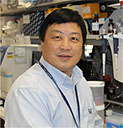


Posted June 28, 2013
Xiao-Nan Li, M.D., Ph.D., Baylor College of Medicine, Houston
 In children, brain tumors are the leading cause of cancer-related deaths; and the worst and most lethal childhood brain tumor is a glioma called "diffuse intrinsic pontine glioma" (DIPG) that occurs at the base of the brain. Although rare, DIPG causes death in most affected children within 1-2 years of diagnosis. Despite decades of effort, little progress has been made in developing new and more effective therapies against this deadly disease. Its critical location in the brain stem, where many basic bodily functions including breathing and heart rate are located, makes DIPG inoperable and affected tissues unavailable for scientific study.
In children, brain tumors are the leading cause of cancer-related deaths; and the worst and most lethal childhood brain tumor is a glioma called "diffuse intrinsic pontine glioma" (DIPG) that occurs at the base of the brain. Although rare, DIPG causes death in most affected children within 1-2 years of diagnosis. Despite decades of effort, little progress has been made in developing new and more effective therapies against this deadly disease. Its critical location in the brain stem, where many basic bodily functions including breathing and heart rate are located, makes DIPG inoperable and affected tissues unavailable for scientific study.
In his efforts to overcome this obstacle in DIPG research, Dr. Li, with support from a Fiscal Year 2007 Peer Reviewed Cancer Research Program Concept Award, proposed to collect tumor tissues during autopsy of deceased children who had suffered from DIPG in the hopes of developing xenograft mouse models for biological and preclinical studies of this devastating childhood brain cancer.
With the support and timeless effort of parent advocate groups from across the country, Dr. Li was able to reach out to DIPG families who were willing to donate brain tissues from their beloved children to medical research through a consented autopsy that involved an intense collaboration of family members, physicians, pathologists, nurses, and autopsy coordinators from different hospitals. Using brain tissue obtained from the deceased children, Dr. Li established five new DIPG cell lines and demonstrated that the surviving tumor cells can cause DIPG tumors similar to the original childhood tumor when injected into the brain stems of mice. Together, the family donors and research teams have established a set of critically needed and clinically relevant animal models for DIPGs that should serve as a valuable resource for the development of new targeted therapies for this cancer. In recognition of their invaluable donations to furthering research into DIPG, Dr. Li proclaims, "We are deeply indebted to the families of DIPG patients. Without their generous support, there would be nothing even close to what we have achieved. What we have achieved is truly a team effort and we appreciate wholeheartedly every aspect of their contributions."
Links:














